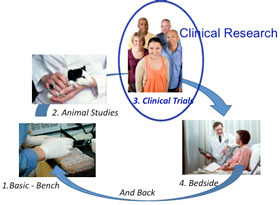 |
|
Eligibility requirements can be both inclusionary
(participants must have) and exclusionary
(participants must not have). Participant eligibility
criteria can range from general (age, sex, type of
cancer) to specific (prior treatment, tumor
characteristics, blood cell counts, organ function).
Eligibility criteria may also vary depending on the
phase of the trial. In Phase 1 and 2 trials, the
criteria often focus on patient safety making sure
that people who might be harmed because of
abnormal organ function or other factors are not
put at risk during the trial. Phase 2 and 3 trials
often add criteria concerning disease type and
stage, and number and type of prior treatments. |
| |
|
|
The more stringent the eligibility criteria, the easier it is to find a treatment effect.
However, the less stringent the eligibility criteria, the more likely the result will be
replicated in the real world outside of clinical trials.
There is much discussion about relaxing eligibility requirements as noted by
biostatistician George Sledge, Division of Biometry, Duke University Medical Center,
Durham, NC: "Phase III clinical trials in cancer should have much broader eligibility
criteria than the traditional restrictive criteria commonly used. Adoption of less
restrictive eligibility criteria for most studies would allow broader generalizations,
better mimic medical practice, reduce complexity and costs, and permit more rapid
accrual without compromising patient safety or requiring major increases in sample
size."
Below is an example of eligibility requirements from a study on the NCI website.
| "Ages Eligible for Study: |
18 Years and older |
| Genders Eligible for Study: |
Female |
| Accepts Healthy Volunteers: |
No |
Inclusion Criteria: (must have)
- Subjects must have histologically or cytologically confirmed adenocarcinoma of the
breast with locally recurrent or metastatic disease. Locally recurrent disease must not
be amenable to resection with curative intent.
- HER2-positive by FISH, CISH, or IHC 3+
- ECOG performance status 0 or 1
- Left ventricular ejection fraction greater than or equal to institutional lower limit of
normal
- Adequate laboratory studies (hematological, chemistries and urinalysis)
- Life expectancy greater than or equal to 3 months
- Cohort A only:
- Subjects must be either trastuzumab na´ve or have had prior trastuzumab in the
adjuvant setting only
- Subjects must not have had a clinically significant drop in cardiac function during a
prior exposure to trastuzumab
- Subjects must have had no prior lapatinib therapy
- At least 3 weeks from enrollment since prior chemotherapeutic agents, including
taxanes, in the neoadjuvant or adjuvant setting
- At least 3 months from enrollment since prior trastuzumab in the neoadjuvant or
adjuvant setting
- Cohort B only:
- Subjects must have failed (due to disease progression or toxicity) trastuzumab in
the first-line metastatic setting. Trastuzumab must be discontinued for at least 3
weeks prior to enrollment
- Subjects must have received prior chemotherapy as adjuvant therapy or for
metastatic disease
- Prior chemotherapy treatment must be discontinued for at least 3 weeks prior to
enrollment
- Subjects must have had no prior capecitabine
- Subjects must have had no prior lapatinib
Exclusion Criteria: (must not have)
- Inflammatory breast cancer
- Current or prior history of central nervous system metastasis
- Clinically significant cardiovascular disease
- Concurrent or prior (within 1 week before enrollment) anticoagulation therapy,
excluding aspirin and anti-platelet agents. The concurrent use of low molecular weight
heparin or low dose warfarin (ie, less than or equal to 1 mg daily) for prophylaxis
against thrombosis is acceptable while on study
- Subjects with a history of prior malignancy, except:
- Malignancy treated with curative intent and with no known active disease present for
greater than or equal to 3 years before enrollment and felt to be at low risk for
recurrence by treating physician
- Adequately treated non-melanomatous skin cancer or lentigo maligna without
evidence of disease
- Adequately treated cervical carcinoma in situ without evidence of disease
- Subjects with interstitial pulmonary disease
- For Cohort B only:
- Current or prior history of long QT syndrome
- Baseline ECG report of QTc interval of > 480 milliseconds
- Severe chronic liver disease (Child Pugh C)"
You can see by the many criteria listed above why suggestions are being made to
relax the eligibility requirements.
Not only do you limit the population of eligible patients by having such strict
requirements but also the patients that meet these requirements do not often
represent the typical patients seen in clinical practice. The more diverse the trial's population, the more useful the results could be to the general public, particularly in
Phase 3 trials.






